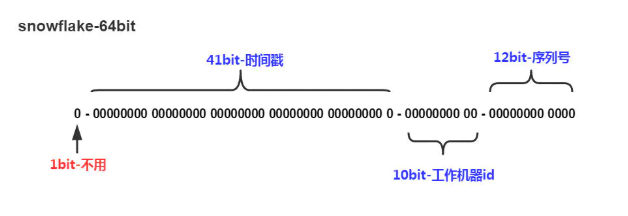分布式id生成算法的有很多种,Twitter的SnowFlake就是其中经典的一种。
算法原理
SnowFlake算法生成id的结果是一个64bit大小的整数,它的结构如下图:

1bit,不用,因为二进制中最高位是符号位,1表示负数,0表示正数。生成的id一般都是用整数,所以最高位固定为0。
41bit-时间戳,用来记录时间戳,毫秒级。
- 41位可以表示
个数字
- 如果只用来表示正整数(计算机中正数包含0),可以表示的数值范围是:0 至
,减1是因为可表示的数值范围是从0开始算的,而不是1
- 也就是说41位可以表示
个毫秒的值,转化成单位年则是
年
10bit-工作机器id,用来记录工作机器id
- 可以部署在
个节点,包括5位datacenterId和5位workerId
- 5位(bit)可以表示的最大正整数是
,即可以用0、1、2、3、....31这32个数字,来表示不同的datecenterId或workerId
12bit-序列号,序列号,用来记录同毫秒内产生的不同id
- 12位(bit)可以表示的最大正整数是
,即可以用0、1、2、3、....4094这4095个数字,来表示同一机器同一时间截(毫秒)内产生的4095个ID序号
由于在Java中64bit的整数是long类型,所以在Java中SnowFlake算法生成的id就是long来存储的
SnowFlake可以保证:
- 所有生成的id按时间趋势递增
- 整个分布式系统内不会产生重复id(因为有datacenterId和workerId来做区分)
算法实现(Java)
Twitter官方给出的算法实现 是用Scala写的,这里不做分析,可自行查看
package com.ihrm.common.utils; public class IdWorker { //下面两个每个5位,加起来就是10位的工作机器id private long workerId; //工作id private long datacenterId; //数据id //12位的序列号 private long sequence; public IdWorker(long workerId, long datacenterId, long sequence) { // sanity check for workerId if (workerId > maxWorkerId || workerId < 0) { throw new IllegalArgumentException(String.format("worker Id can't be greater than %d or less than 0", maxWorkerId)); } if (datacenterId > maxDatacenterId || datacenterId < 0) { throw new IllegalArgumentException(String.format("datacenter Id can't be greater than %d or less than 0", maxDatacenterId)); } System.out.printf("worker starting. timestamp left shift %d, datacenter id bits %d, worker id bits %d, sequence bits %d, workerid %d", timestampLeftShift, datacenterIdBits, workerIdBits, sequenceBits, workerId); this.workerId = workerId; this.datacenterId = datacenterId; this.sequence = sequence; } //初始时间戳 private long twepoch = 1288834974657L; //长度为5位 private long workerIdBits = 5L; private long datacenterIdBits = 5L; //最大值 private long maxWorkerId = -1L ^ (-1L << workerIdBits); private long maxDatacenterId = -1L ^ (-1L << datacenterIdBits); //序列号id长度 private long sequenceBits = 12L; //序列号最大值 private long sequenceMask = -1L ^ (-1L << sequenceBits); //工作id需要左移的位数,12位 private long workerIdShift = sequenceBits; //数据id需要左移位数 12+5=17位 private long datacenterIdShift = sequenceBits + workerIdBits; //时间戳需要左移位数 12+5+5=22位 private long timestampLeftShift = sequenceBits + workerIdBits + datacenterIdBits; //上次时间戳,初始值为负数 private long lastTimestamp = -1L; public long getWorkerId() { return workerId; } public long getDatacenterId() { return datacenterId; } public long getTimestamp() { return System.currentTimeMillis(); } //下一个ID生成算法 public synchronized long nextId() { long timestamp = timeGen(); //获取当前时间戳如果小于上次时间戳,则表示时间戳获取出现异常 if (timestamp < lastTimestamp) { System.err.printf("clock is moving backwards. Rejecting requests until %d.", lastTimestamp); throw new RuntimeException(String.format("Clock moved backwards. Refusing to generate id for %d milliseconds", lastTimestamp - timestamp)); } //获取当前时间戳如果等于上次时间戳(同一毫秒内),则在序列号加一;否则序列号赋值为0,从0开始。 if (lastTimestamp == timestamp) { sequence = (sequence + 1) & sequenceMask; if (sequence == 0) { timestamp = tilNextMillis(lastTimestamp); } } else { sequence = 0; } //将上次时间戳值刷新 lastTimestamp = timestamp; /** * 返回结果: * (timestamp - twepoch) << timestampLeftShift) 表示将时间戳减去初始时间戳,再左移相应位数 * (datacenterId << datacenterIdShift) 表示将数据id左移相应位数 * (workerId << workerIdShift) 表示将工作id左移相应位数 * | 是按位或运算符,例如:x | y,只有当x,y都为0的时候结果才为0,其它情况结果都为1。 * 因为个部分只有相应位上的值有意义,其它位上都是0,所以将各部分的值进行 | 运算就能得到最终拼接好的id */ return ((timestamp - twepoch) << timestampLeftShift) | (datacenterId << datacenterIdShift) | (workerId << workerIdShift) | sequence; } //获取时间戳,并与上次时间戳比较 private long tilNextMillis(long lastTimestamp) { long timestamp = timeGen(); while (timestamp <= lastTimestamp) { timestamp = timeGen(); } return timestamp; } //获取系统时间戳 private long timeGen() { return System.currentTimeMillis(); } //---------------测试--------------- public static void main(String[] args) { IdWorker worker = new IdWorker(1, 1, 1); for (int i = 0; i < 30; i++) { System.out.println(worker.nextId()); } } }
关于本文介绍雪花算法,大家可以参考(煲煲菜的博客):https://segmentfault.com/a/1190000011282426